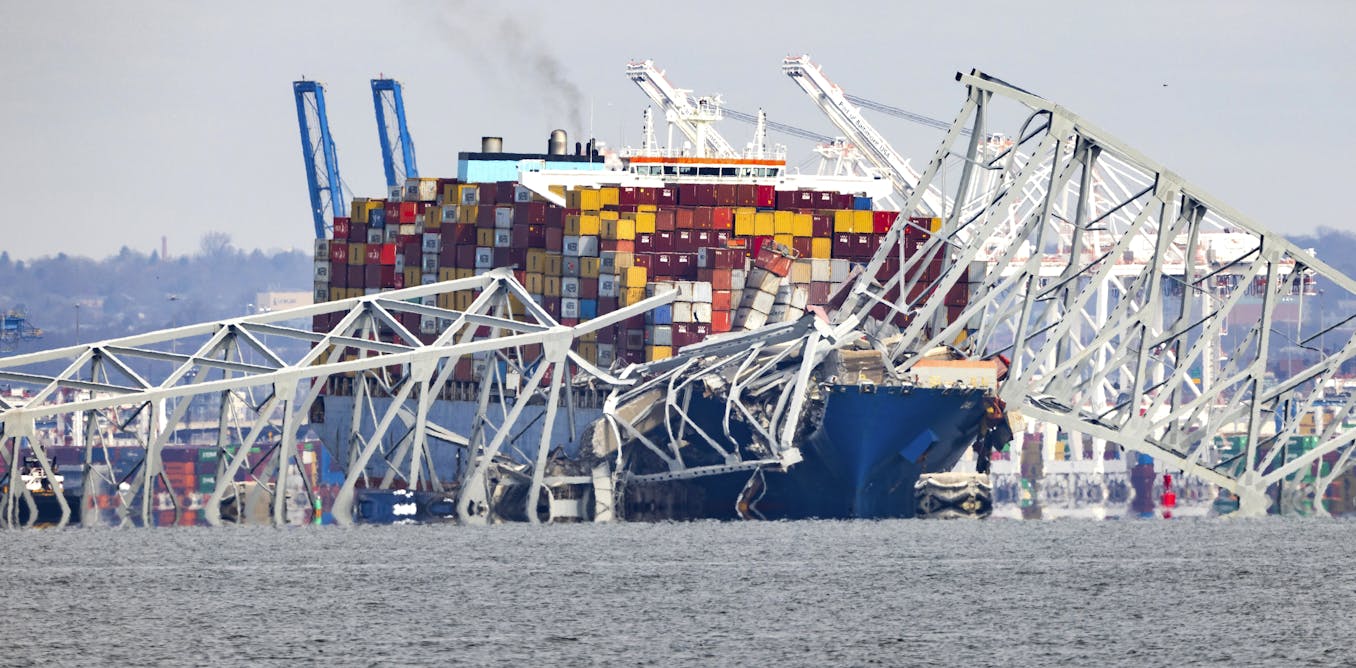Baltimore Key Bridge: how a domino effect brought it down in seconds
We’ll need to learn the lessons from this disaster. The collapse of the Francis Scott Key Bridge in Baltimore on 26 March led to a domino effect, where the world's third largest continuous truss bridge fell into the Patapsco river. The cause was the Singapore-flagged container ship, the Dali, which veered off course and collided with one of the bridge's supports, causing the collapse. The bridge, built over 45 years ago, was designed as a continuous system, meaning the extra weight from the damaged pier increased the strain on the remaining truss structure. This type of collapse can have catastrophic consequences, including risk to human life and the local environment. However, bridge designers are aware of the potential for collisions, but these are rare events. The collision force under some scenarios is likely to exceed the capacity of bridge piers to withstand.

प्रकाशित : 4 सप्ताह पहले द्वारा Mohamed Shaheen, Lecturer in Structural Engineering, Loughborough University में
The collapse of the Francis Scott Key Bridge in Baltimore on 26 March was a shocking and tragic event. Six people remain unaccounted for in the disaster, which saw the world’s third largest continuous truss bridge fall into the Patapsco river.
The cause was Singapore-flagged container ship, the Dali, which veered off course, colliding with one of the bridge’s supports, or piers. As the 300 metre-long vessel slammed into the structure, leading to what’s known as a progressive collapse, where a domino effect leads to the entire structure failing. The bridge, built more than 45 years ago, crashed down into the frigid water at 1:28am eastern standard time (5:28 UTC).
But how could one ship bring down this 366m (1,200 ft) structure within seconds of the collision?
Engineers classify this type of bridge failure as a progressive collapse. This involves the failure of a single element, like the pier, which triggers a domino effect.
This leads to the sequential failure of other connected components, such as the metallic truss and the bridge’s deck. This type of collapse can have catastrophic consequences in terms of the risk to human life, as well as to the economy of an area and the local environment.
Although it’s impossible to account for every scenario, bridges can be built with inherent features that enhance their resistance to progressive collapse. Typically, bridges can withstand some degree of damage to a pier or part of the superstructure. The bridge deck can even remain safe for vehicles depending on the circumstances.
However, in the case of the Baltimore bridge collapse, the metallic truss was designed as one continuous system. The space between each support, or pier, is known as the truss span. The collapse of one of the piers effectively doubled the truss span to the next support. This dramatic increase in span exerted a much larger force on the remaining truss structure.
While continuous truss systems are favoured because they can redistribute weight in the event of damage, in this case, the remaining truss elements couldn’t withstand all that extra force after the pier failed.
This resulted in the complete collapse of the truss section above the damaged pier. The collapse didn’t stop there, however. Due to the interconnected nature of the trusses, the remaining section was initially pulled upwards. The sudden release of this tension created a powerful dynamic effect, ultimately causing the entire bridge to collapse.
It’s certainly not unknown for ships to strike bridge supports. On May 9, 1980, a strikingly similar event took place when a freighter collided with a support pier of the Sunshine Skyway Bridge in Tampa Bay, Florida. As a result, the bridge failed over a similar distance as the Baltimore collapse.
But while bridge designers are acutely aware of the potential for collisions, these are – at the same time – rather rare events. The impact forces on a support pier are also highly variable. A higher speed or heavier ship will significantly increase the force on the pier. And higher vessel traffic in the water boosts the probability of a collision.
In addition, the current method used in the US for calculating the collision force of a ship is based on research conducted between 1967 and 1976. However, a different method would have been used for the Key Bridge, which opened in 1977. Needless to say, vessels as heavy and fast as the Dali were not a common sight in 1977.
In fact, the collision force under some scenarios is likely to be well beyond the capacity of bridge piers to withstand. This is why bridges have other systems of protection, such as dolphins – a group of pilings situated in the water near a pier, which serve to deflect a vessel or take the energy out of a collision.
There isn’t any information about the system that was installed when the Key Bridge opened in 1977. And some observers have questioned whether the protective barriers around the Baltimore bridge were sufficient.
Regular structural assessments and retrofits are crucial to ensure a bridge meets current safety standards. Concrete and steel, the primary materials in this bridge, are susceptible to deterioration from factors like corrosion and other environmental conditions.
In general, insufficient maintenance or inadequate retrofits can be contributing factors when bridges collapse. However, it must be said there is no evidence this was a factor in this case – and the Key Bridge was said to be “up to code” when the disaster occurred.
There will be more detail to come on this dramatic and tragic event. And the findings will surely inform future approaches to the design and protection of bridges across busy waterways.
